
All iLive content is medically reviewed or fact checked to ensure as much factual accuracy as possible.
We have strict sourcing guidelines and only link to reputable media sites, academic research institutions and, whenever possible, medically peer reviewed studies. Note that the numbers in parentheses ([1], [2], etc.) are clickable links to these studies.
If you feel that any of our content is inaccurate, out-of-date, or otherwise questionable, please select it and press Ctrl + Enter.
Effective treatment of foot fungus with ointments
Medical expert of the article
Last reviewed: 07.07.2025
Fungal infections of the feet, the most common of which are mycosis of the feet and onychomycosis of the nails, are some of the most unpleasant, but very common diseases. The fungus easily finds a new host, but getting rid of the unwanted guest can be very difficult. And if in the early stages of the disease, long-term use of local antifungal agents is often sufficient, namely: emulsions, sprays, varnishes, creams, including ointments for foot and nail fungus, then an advanced process requires a comprehensive approach, in which local treatment of the disease is combined with oral medication.
ATC classification
Pharmacological group
Pharmachologic effect
Topical treatment for athlete's foot
It is almost impossible to cure fungal skin diseases without directly affecting the skin from the outside. That is why the most common form of release of drugs for foot fungus are ointments, which are intended for external use.
Indications for the use of ointments for foot fungus: fungal diseases of the skin of the feet and nails at an early stage, as part of complex therapy for progressive fungal infection, prevention of fungal diseases of the skin. Forms of antifungal agents in the form of creams and ointments act only in different layers of the skin, practically not being absorbed into the blood. This means that contraindications to their use are mainly associated with hypersensitivity to the drug, which manifests itself in the form of such side effects of ointments for foot fungus as increased itching, redness, dryness and noticeable peeling of the skin in places where the ointment is applied.
Pharmacodynamics and pharmacokinetics of ointments used in the treatment of foot fungus depend on the composition of the drug. All ointments for fungal infections are famous for their more or less destructive effect on fungal cells, which is what causes the antifungal effect. These drugs may contain components that relieve itching and irritation, promote healing of skin wounds, and have anti-inflammatory and antimicrobial effects.
Some antifungal agents are active against a specific type of infectious agent, while others have a broad spectrum of action, which means they are effective against different types of parasitic fungi.
The method of application and dosage of ointments for foot fungus may also differ. However, there are some nuances of their application that are relevant for all antifungal ointments. This concerns the preparation of the skin for application of the ointment and the prevention of the spread of fungal infection.
It is advisable to apply the ointment for foot fungus only after cleansing the skin of the lower part of the legs. For this, use ordinary warm water and soap. The legs are thoroughly washed and wiped dry with a clean towel, which is used only during illness and washed after each use. The latter requirement will prevent the spread of infection to other areas of the skin.
Just as the treatment of a fungal nail infection requires maximum filing of the nail plate before applying varnish or ointment, so the therapy of foot fungus is effective when removing the "dead" keratinized skin, previously softened by warm water. For this, you can use a hard sponge, pumice or a special brush.
The cream should be applied in a thin layer, and not only the affected area should be treated, but also the skin around it at a distance of at least 10 mm. If there is more than one such area, then all areas affected by the fungus should be treated simultaneously, including the fungus on the nails.
Treatment of foot fungus involves following the necessary hygiene measures, such as keeping the skin of the feet clean and dry, frequently changing socks and bed linen that have come into contact with the affected areas of the skin, treating shoes with special antifungal sprays and solutions. To disinfect and remove unpleasant shoe odor, an inexpensive but effective veterinary drug called "Biopirox" is sometimes used, which is available as a spray.
Ointments for foot fungus that do not give a positive effect within 2 weeks should be replaced with other, more effective ones, or used in combination with tablets or other ointments. Diagnosis and treatment of any fungal diseases should be carried out with the participation and under the supervision of a specialist doctor, otherwise you can only harm yourself, incompetent actions causing the spread of infection to other parts of the body.
Names and uses of ointments for foot fungus
For the treatment of fungal skin lesions, the pharmaceutical industry produces 3 main types of antifungal drugs with different active ingredients:
- Ointments based on azole derivatives: miconazole, clotrimazole, fluconazole, ketoconazole, isoconazole, econazole, effective against some types of fungi.
- Ointments based on allylamines: terbinafine and naftifine, which have a broader spectrum of action.
- Combination preparations with the addition of antibacterial components, anti-inflammatory (corticosteroids) and skin-restoring (keratolytics) components.
Let's look at the most popular and equally effective ointments for foot fungus that doctors prescribe for various types of fungal infections of the feet.
Known to many for its antifungal properties, the drug "Clotrimazole" in the form of a cream is often used to treat foot fungus. This is a relatively inexpensive and safe ointment for foot fungus, because it does not have a negative effect on the body, since it acts only in the skin, without entering the bloodstream.
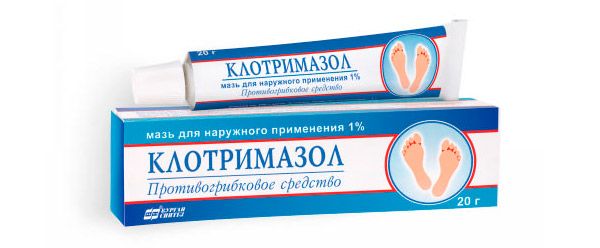
Treatment of athlete's foot with Clotrimazole usually lasts for 6 weeks or more with 2-3 applications during the day (daily).
It is not recommended to use Clotrimazole ointment simultaneously with nystatin, natamycin, amphotericin B, as they can reduce the effectiveness of clotrimazole.
Side effects of the drug are very rare. These may include allergic reactions accompanied by redness and itching, as well as slight tingling and peeling in the areas where the ointment is applied.
The ointment should be stored in a place protected from light, and the air temperature in the storage area should not exceed 20 degrees. The shelf life with proper storage is 2 years.
"Candide" is a drug based on clotrimazole, belonging to the 1st group of ointments for fungus. The active substance - clotrimazole - has a destructive effect on fungal cells, while it quickly penetrates into various layers of the skin, providing a therapeutic effect there.
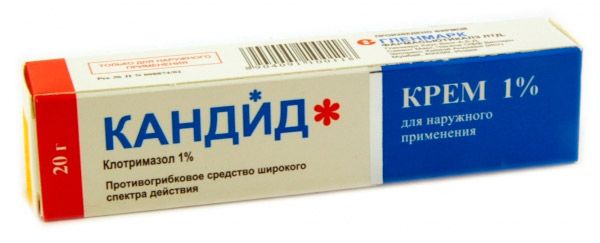
Applying the cream twice or three times a day allows you to remove the symptoms of fungal skin disease in 2-3 weeks, however, the therapy should not end there, since there is a high probability of recurrence of symptoms. Therefore, the treatment should be continued for another 2-3 weeks to prevent relapses.
Overdose of the drug when applied externally is not observed. However, minor side effects in the form of skin irritation at the beginning of taking the drug are possible. Usually, such irritation does not require discontinuing the drug and goes away on its own.
Interaction with other drugs. "Candide" is not recommended to be used together with drugs containing nystatin, since the latter reduces the effect of the ointment.
It is not advisable to apply Candide ointment to damaged skin, as this may cause additional irritation.
The shelf life of the ointment "Candide" is 2 years, provided it is stored correctly. That is, the drug should be stored in a dark place with a temperature not exceeding 25 degrees.
"Candide B" is a drug with a combined composition, belonging to the third group of antifungal agents. The main active ingredient is clotrimazole, the additional one is beclomethasone.
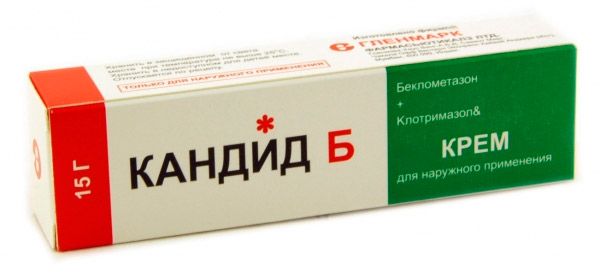
Pharmacodynamics. Clotrimazole provides the antifungal effect of the ointment, disrupting the synthesis of the components necessary for the fungal cells, which makes the fungus incapable. The anti-inflammatory effect of the drug is associated with beclomethasone, which also relieves itching associated with fungal infections of the feet.
Method of administration and dosage. Candid B ointment is applied to the skin at the site of fungal infection at least 2-3 times a day, like the previous drug. But unlike it, skin disorders are not contraindications for the use of Candid B. The drug is not intended for long-term treatment of large areas of skin affected by fungus.
This drug can be stored for 3 years from the date of manufacture at a temperature below 25 degrees.
The use of ointments for foot fungus "Clotrimazole", "Candide" and "Candide B" during pregnancy and breastfeeding is possible only according to the doctor's instructions due to insufficient study of their effect on the development of the child.
"Fucis" in the form of a gel is also effective for mycosis of the feet, it belongs to the 1st group of antifungal drugs. The main active ingredient of the drug is fluconazole.
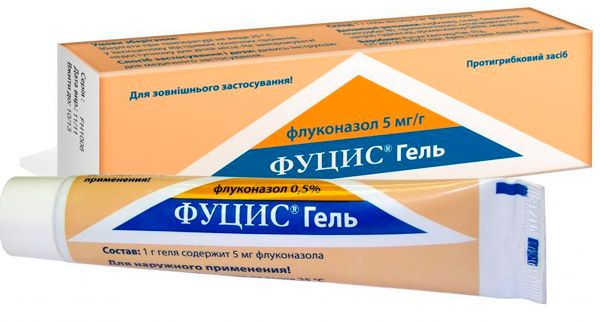
Pharmacodynamics. Fluconazole in the drug is a powerful antifungal agent that helps destroy the cellular structure of the fungus.
Pharmacokinetics. The ointment is well absorbed into the skin and does not cause any disturbances in the body. Reactions of intolerance to the drug are very rare. A small part of the drug when applied externally can enter the bloodstream, but it is not capable of causing harm to a person.
To obtain the necessary therapeutic effect, it is enough to apply a small amount of ointment to the affected skin once a day, capturing adjacent healthy areas of skin. Then massage the gel into the skin with light movements. The course of treatment depends on the localization of the process and the type of pathogen.
If the use of fluconazole causes skin irritation, it is better to change the drug to another one. It is not advisable to use other topical drugs together with Fucis.
Lamisil cream is a fairly popular and effective ointment for foot fungus. The drug belongs to the second group of antifungal agents, since its active ingredient is terbinafine.
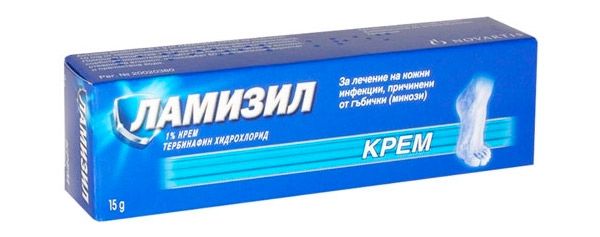
Pharmacodynamics. The drug not only prevents the synthesis of building materials of the fungal cell, but also saturates the fungi with toxic substances, leading to their rapid death. "Lamisil" in the form of an ointment is effective for mycosis of the feet, but in the case of nail fungus it does not have sufficient effect.
The ointment should be applied 2 times a day. This will allow you to get rid of foot fungus within 3-6 weeks. The rapid relief of fungal infection symptoms with Lamisil cream is its advantage, but not a signal to stop "military" actions against the fungus. Even if you observe a complete disappearance of all symptoms of the disease in the first days and weeks of treatment with the drug, you should not interrupt the treatment for at least another 2 weeks.
Method of application and dosage. Apply a small amount of ointment to the clean and dry surface of the foot and the interdigital space, gently rubbing into the skin. Use 1 or 2 times a day. The course of treatment is quite short - 1-2 weeks, but to avoid relapses, use of the ointment once a day should be continued for another couple of weeks.
When applied externally, overdose of the drug is not observed. Side effects sometimes include slight redness and burning or itching at the site of application of the ointment.
The drug has a fairly long shelf life of 5 years and does not require special storage conditions, perfectly tolerating ambient temperatures up to 30 degrees.
A cheaper analogue of "Lamisil" is a drug whose name immediately indicates the active substance. In principle, the action and method of application of the cream "Terbinafine" coincides with the instructions for "Lamisil" in all respects. The only difference is the expiration date (2 years) and storage conditions (t not higher than 25 o C).
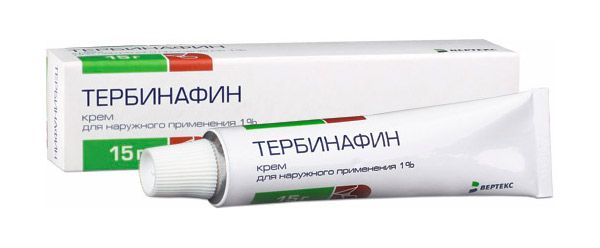
The ointments "Mikonorm" and "Termikon" are similar to "Terbinafine" in all respects, but their price is between "Terbinafine" and "Lamisil".
Another popular antifungal drug, Exoderil, which is successfully used in the form of an ointment to treat foot fungus, is also not a cheap pleasure. This is a drug from the second group of antifungal agents based on naftifine.
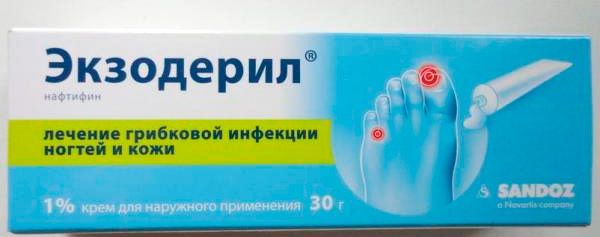
Pharmacodynamics. The drug has a pronounced fungicidal, fungistatic, anti-inflammatory and antibacterial effect. It not only kills the fungus, but also prevents the occurrence of secondary bacterial infections. Due to the anti-inflammatory effect, the ointment quickly relieves swelling and itching at the site of the fungus.
Pharmacokinetics. Naftifine has good penetrating ability, due to which it works successfully in various layers of the skin. Only about 6% of the substance gets into the bloodstream, which cannot harm the patient's health.
Method of application and dosage. The ointment is used no more than once a day. The course of treatment can be from 2 to 8 weeks. If the fungus affects not only the skin but also the nails, the treatment can last up to six months.
The antifungal ointment "Exoderil" is intended for the treatment of adult patients; the possibility of treating children with it is considered by the doctor individually.
"Exoderil" has a fairly long shelf life (3 years) and is not picky about storage conditions (withstands temperatures from 0 to 30 ° C).
A full-fledged analogue of Exoderil is the ointment Naftifin with an even longer shelf life (5 years).
Far from cheap, but effective remedies for foot fungus are the popular drugs "Nizoral" based on ketoconazole and "Batrafen" with the active ingredient ciclopirox. To treat fungal infections of the feet, these drugs are used in the form of ointments and creams. At the same time, "Batrafen" has excellent penetrating ability and excellent fungicidal action against most fungi, and "Nizoral" - quickly relieves the unpleasant symptoms of fungal infection, in particular itching and odor.
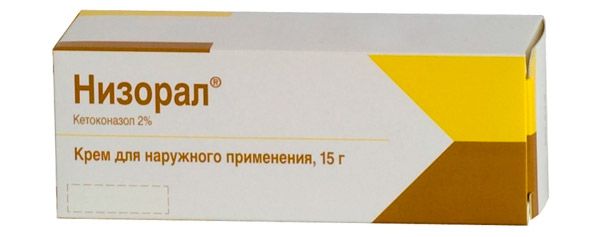
These ointments for foot fungus are usually applied 1 or 2 times a day. The course of treatment very rarely exceeds 4 weeks.
"Batrafen" is intended for the treatment of patients over 10 years old, "Nizoral" is also used to treat young patients.
The shelf life of Batrafen ointment is 2 years, provided it is stored in a room with an air temperature no higher than 25 degrees.
Nizoral ointment is more sensitive to temperatures, so the range of acceptable temperatures ranges from 15 to 30 o C. If these conditions are met, the shelf life of the drug is 5 years.
Analogues of the cream "Nizoral" can be called ointments "Dermazol", "Mikozoral" and "Miconazole" with the same active substance (ketoconazole), using which at least 2 times a day, you can achieve a cure for foot fungus in 2-6 weeks.
Inexpensive little-known ointments for foot fungus
The most popular antifungal agents were discussed above, and now let's look at less common, but no less effective ointments for foot fungus, which will please the buyer both with the price and the result obtained from their use.
Cream "Ekodak" - antifungal drug based on econazole. This is a product from the 1st group of antifungal drugs with an average price.
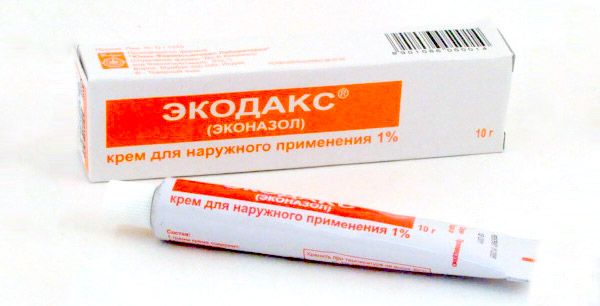
Pharmacodynamics. Econazole has a broad spectrum of activity against various fungi and shows a noticeable bactericidal effect. Destroys even those fungi that are resistant to other drugs. At the same time, econazole is famous for its enviable speed of action and destroys fungal infection with unpleasant symptoms accompanying the fungus's vital activity in the first three days.
Pharmacokinetics. The active substance can easily penetrate into various layers of the skin and the nail plate, so the drug is successfully used to treat foot mycoses and nail onychomycosis. When applied externally, it practically does not enter the blood.
Contraindications for use include cases of hypersensitivity to the drug and azole derivatives. The ointment is also not intended for the treatment of patients under 18 years of age. Side effects are common for antifungal ointments: a feeling of dryness, peeling, slight burning, redness, and sometimes increased itching.
The ointment is effective when used twice a day. The therapeutic course can be from 2 weeks to 6 months depending on the skin condition.
Storage conditions. The ointment must be stored at a temperature not lower than 0 o C and not higher than 30 o C in a dark place. The shelf life of the ointment under such conditions is 3 years.
"Gribkosept 911" is a combined inexpensive drug in the form of a gel that successfully helps treat foot fungus at the early stages of the disease. The main active ingredients are triclosan (a powerful antifungal and antimicrobial component) and allantoin (promotes softening and renewal of keratinized skin).
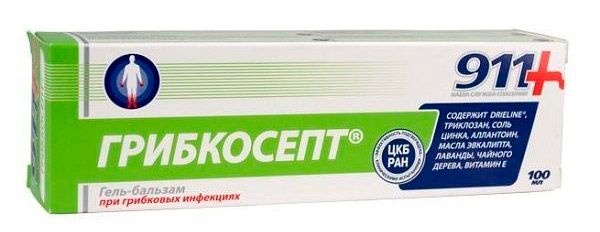
Pharmacodynamics. The drug actively fights fungal infection, preventing recurrence of the disease. It is an excellent preventive measure against fungal infection. Inactive in case of nail onychomycosis.
Method of application and dosage. The use of this ointment for foot and hand fungus for therapeutic purposes involves applying the ointment with light massage movements to the affected areas of the skin in a thin layer 2 times a day. The course of therapy usually lasts from 4 to 6 weeks. For preventive purposes, it is enough to use the ointment once a week. The drug has no side effects, so to prevent fungal infection, it can be used every time you visit a bathhouse, swimming pool, sauna, and other "hot spots".
The product is not intended for use in children under 2 years of age. It is not recommended for use during pregnancy and breastfeeding. It is also not recommended to use the ointment in case of allergic reactions.
Ointment "Fundizol" is a more than interesting antifungal agent with a combined composition, showing decent activity against all types of fungi. It can be used to treat fungal skin lesions, onychomycosis, as well as acne and ingrown nails. The drug also helps to quickly relieve itching from insect bites and other skin irritations. "Fundizol" is also indispensable as a preventive agent, helping to avoid fungal infection on the beach, in the bathhouse and other public places where fungal infections like to live.
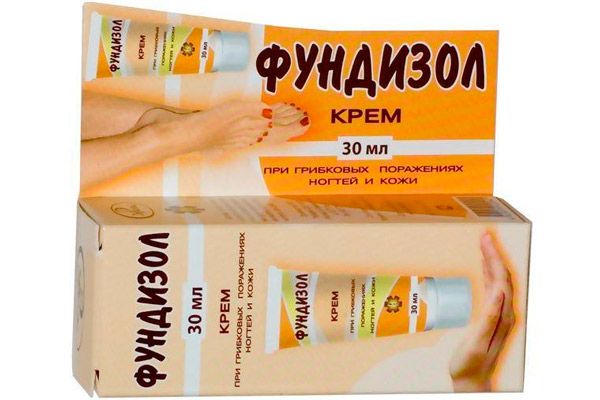
Despite the fact that the cream "Fundizol" is not a full-fledged medicinal product (it is rather a care product with an antifungal and moisturizing effect), due to its effectiveness in the fight against fungus, it takes its rightful place on pharmacy shelves.
The ointment has virtually no contraindications for use, except for hypersensitivity to the substances included in the drug. It does not harm healthy skin, so it can be used as a health and care product for the skin, including the skin of the feet. This is a good preventative for both fungal diseases and excessive sweating of the feet. "Fundizol" also effectively combats the unpleasant odor coming from the feet, the cause of which is often the same ill-fated fungal infection.
To combat nail onychomycosis, Fundizol ointment is used 2 times a day with subsequent exposure for 5-6 hours. To treat and prevent foot dermatomycosis, it is sufficient to apply the product to the skin twice or three times a day using a light massage.
The cream is quite greasy (but absorbs well), so it is advisable to apply it pointwise and then distribute it over the skin. Due to this property, the ointment is quite economical in terms of consumption. And the price of the product is quite pleasant.
Non-specific remedies for foot fungus
Sometimes, in the process of using medicines, some of their properties are unexpectedly discovered, allowing these drugs to be used to treat diseases not indicated in the attached instructions. This happened with the ointments we are accustomed to:
- sulfuric (known to many as a remedy for ringworm),
- salicylic (acne and lichen),
- zinc (wounds, burns, diaper rash, eczema, herpes).
Sulfur ointment is an inexpensive antiseptic used for various skin diseases (scabies, seborrhea, psoriasis, lichen). It has virtually no contraindications for use, except for sulfur intolerance, as well as side effects, and is non-toxic, which makes it possible to use it to treat children and pregnant women.
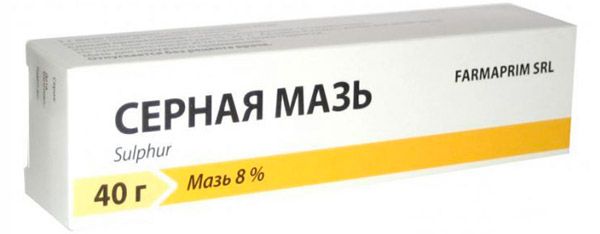
By the way, sulfur ointment is also used in veterinary medicine, which once again confirms its safety for animals, and therefore for people.
It is also active against some fungi that parasitize the human body. This ointment may not be as effective as popular specialized remedies for fungal infections, but there is no reason to deny its effectiveness. The main thing is regularity and patience, because the product has a far from French aroma, and is also difficult to remove, and the yellow oily marks that the ointment leaves on linen and clothing are very difficult to wash off. That is, to treat with sulfur ointment, you will have to use special old clothes and bed linen, which you will not mind throwing away later.
However, if there is no choice, then sulfur will help with early manifestations of foot fungus if you use sulfur ointment daily a couple of times a day for a week. The ointment should be applied to the areas affected by the fungal infection and gently rubbed into the skin. For onychomycosis of the nails, the ointment is less effective than for dermatomycosis of the feet, since it penetrates the nail plate with difficulty.
Salicylic acid-based ointment is also an antiseptic for the treatment of skin diseases and has a noticeable antifungal effect.

To treat foot fungus, apply the ointment to the surface of the foot and toes damaged by the fungus and rub it into the skin. Repeat the procedure up to 3 times a day, first removing any ointment residue from the previous application from the skin surface. Usually, treatment with salicylic ointment lasts 1-3 weeks.
Salicylic ointment is not used to treat infants in the first year of life, as well as patients with intolerance to drugs based on salicylic acid. Side effects of the ointment are usually a consequence of an allergic reaction of the body (itching, redness and a noticeable burning sensation on the skin after applying the ointment).
Interaction with other drugs. Salicylic ointment is incompatible with Resorcinol and drugs containing zinc oxide.
Even more effective for mycosis of the skin is sulfur-salicylic ointment, used for various skin diseases. In it, salicylic acid enhances the antifungal properties of sulfur, which gives a noticeable effect in the treatment of foot fungus.
Zinc ointment is an inexpensive zinc oxide ointment used for wounds and diaper rash on the skin, and is also effective against athlete's foot, with a drying and exfoliating effect. It has virtually no contraindications, and side effects are caused by an allergic response of the body, which happens very rarely.
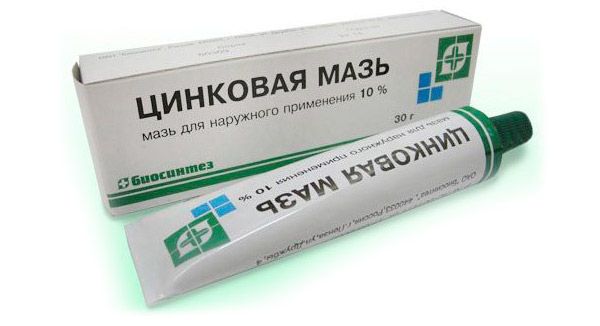
The use of zinc ointment for foot fungus requires multiple applications (up to 5 times a day). It can be used to treat small children, pregnant women, and the elderly.
There is an opinion that you can get rid of foot fungus by using Vishnevsky ointment containing tar. However, dermatologists do not support this statement, insisting that it is impossible to cure foot fungus with Vishnevsky ointment. You can temporarily reduce the external manifestations of the disease, but after stopping treatment with the ointment, the symptoms will return again.
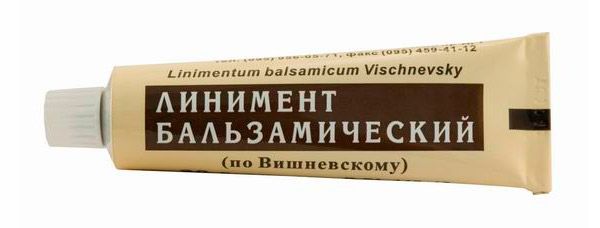
But Wilkinson's ointment, which contains sulfur and tar, can be used as an antifungal agent, which it actually is. In addition, the ointment has an antiseptic, antiparasitic and anti-inflammatory effect.
Wilkinson's ointment for treating foot fungus should be used twice a day for 1-3 weeks. In this case, you will have to put up with the unpleasant smell of tar coming from the ointment.
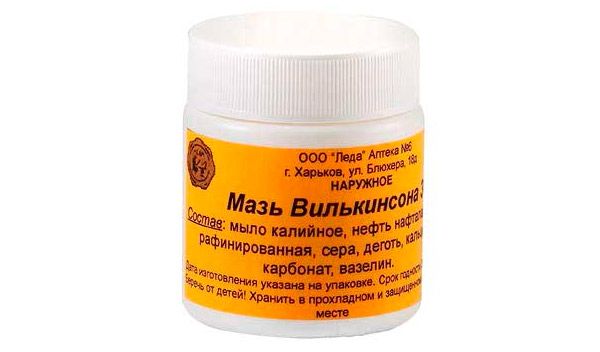
The ointment is not used in patients with chronic renal failure. Contraindications to the use of the ointment include hypersensitivity to the components of the drug. Side effects occur extremely rarely in the form of dermatitis.
And finally, the most non-specific ointment is the antifungal veterinary drug for the treatment of animals "Unisan", which unexpectedly found a second use (this time in humans) in the form of an ointment for foot and nail fungus.
In case of foot fungus development, Unisan ointment is used 1-3 times a day, applying to the areas damaged by the fungal infection and lightly rubbing into the skin. Usually, the symptoms of the disease completely disappear after 1-1.5 weeks.
The shelf life of all the listed non-specific ointments is 2 years, if, of course, the storage conditions specified in the instructions are observed: protection from direct sunlight and the ambient temperature is not higher than 20-25 o C.
And finally…
It is worth recalling one fact once again: despite the fact that local treatment provides relative safety to the patient, preventing significant doses of the drug from entering the blood, it would not hurt to take some precautions. This is especially true for people prone to allergic reactions, pregnant women, nursing mothers and small children.
Since antifungal drugs have not been tested on pregnant women, the use of antifungal ointments during pregnancy and breastfeeding implies a certain risk for the baby. And whether this risk is justified can only be decided by a doctor, and by the woman herself, who is expecting a child or breastfeeding.
And another well-known rule: timely and correct treatment is the key to a quick and complete recovery. You should not diagnose and prescribe treatment for yourself. For the treatment to be effective, it is necessary to identify the causative agent of the fungal disease. And this requires medical experience, practice and certain studies that can only be conducted by a specialist doctor.
You should also not let the process take its course, hoping that everything will go away on its own. This will not happen. The disease will progress, which means that more serious and expensive treatment will be required in the future. In the case of an advanced process that affects the skin and nails, you should not place great hopes on ointments, since this situation requires complex treatment with various forms of antifungal agents.
It is up to you and your doctor to decide whether to buy expensive popular antifungal products, use cheaper analogues, or use non-specific medications and folk remedies. But if you do not adhere to the rules of personal hygiene, perform procedures patiently, regularly, and follow the instructions for the medications, no best ointments for foot fungus will help solve the problem once and for all.
Attention!
To simplify the perception of information, this instruction for use of the drug "Effective treatment of foot fungus with ointments" translated and presented in a special form on the basis of the official instructions for medical use of the drug. Before use read the annotation that came directly to medicines.
Description provided for informational purposes and is not a guide to self-healing. The need for this drug, the purpose of the treatment regimen, methods and dose of the drug is determined solely by the attending physician. Self-medication is dangerous for your health.


 [
[